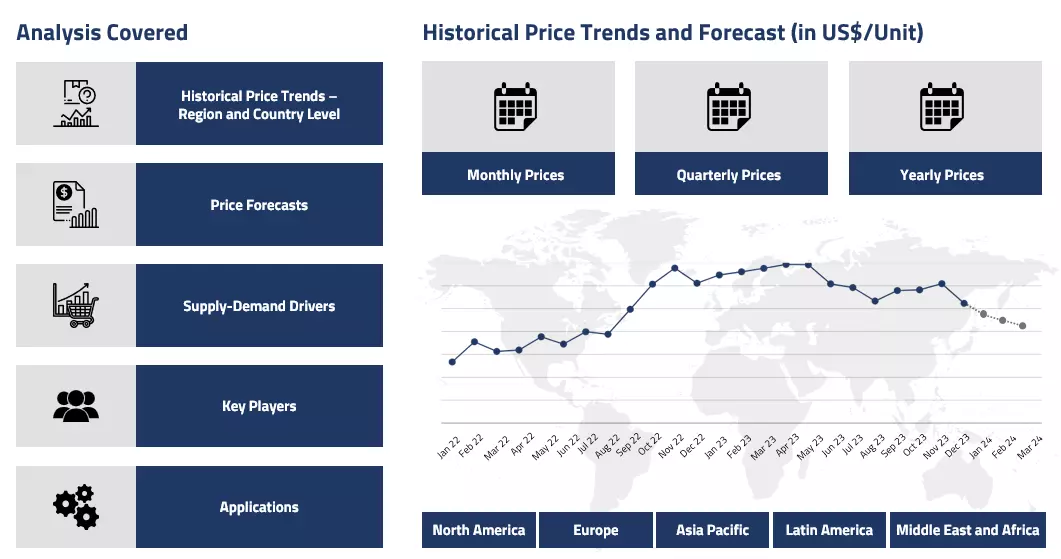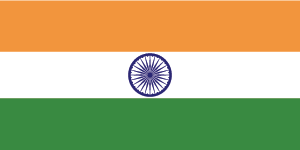Product
Polyethylene (PE) Price Trend and Forecast
Polyethylene (PE) Price Trend and Forecast
Polyethylene (PE) Regional Price Overview
Get the latest insights on price movement and trend analysis of Polyethylene (PE) in different regions across the world (Asia, Europe, North America, Latin America, and the Middle East & Africa).
Polyethylene (PE) Price Trend for Q2 of 2025
Asia
During Q2’25, polyethylene (PE) prices in Asia continued to face downward pressure. Demand from key sectors like packaging, textiles, and consumer goods remained weak, largely due to slow post-pandemic recovery and cautious buying patterns. China’s PE import volumes showed signs of shifting away from U.S. suppliers due to ongoing trade tensions, while regional supply remained ample with high inventory levels and minimal restocking momentum.
Polyethylene Price Chart

Please Login or Subscribe to Access the Polyethylene Price Chart Data
Although some Middle Eastern plants underwent maintenance, the limited impact on supply meant prices saw little support. Competitive offers from Southeast Asian and Indian producers further weighed on market sentiment. Overall, the PE market in Asia stayed sluggish throughout the quarter.
Europe
In Europe, PE prices declined steadily over Q2 amid weak demand and persistent oversupply. The region continued to struggle with low operating rates and structural inefficiencies, prompting announcements like the planned closure of older crackers by major producers. End-use industries such as construction and consumer packaging were particularly slow, and demand remained underwhelming even during the typical peak season.
Additionally, European producers faced competitive pricing pressure from imported material, particularly from the Middle East. Tariff concerns related to U.S. exports also lingered in the background, though their direct impact on Q2 pricing was limited. Overall, the market remained oversupplied and fragile, pushing PE prices lower.
North America
North American PE prices saw a downward trend in Q2’25, driven by weak domestic consumption and high export dependency. U.S. producers increasingly faced difficulties due to potential retaliatory tariffs from multiple countries, including China and possibly Europe. With over 50% of production going to exports, trade disruptions became a growing concern.
At the same time, production resumed quickly after early-year weather disruptions, adding to already elevated inventory levels. Buyers remained cautious, especially as global demand failed to pick up. Limited movement in ethylene feedstock costs also provided little support to PE pricing, reinforcing the soft market.
Analyst Insight
According to Procurement Resource, Polyethylene (PE) prices are expected to stay under pressure unless global demand recovers meaningfully or supply cuts begin to reduce the overcapacity weighing on the market.
Polyethylene (PE) Price Trend for Q1 of 2025
Polyethylene prices in Asia fluctuated throughout the first quarter of 2025, influenced by volatile ethylene prices and uncertain downstream demand. At the beginning of the quarter, stable manufacturing activity and modest demand from sectors such as packaging and consumer goods supported a slight increase in polyethylene prices.
However, as feedstock ethylene prices declined due to weak naphtha markets, polyethylene manufacturers struggled to maintain price levels. Uncertainty in demand led buyers to avoid large orders, opting instead for smaller, short-term purchases. High-density polyethylene producers faced additional challenges due to cash flow constraints. By the end of the quarter, restrained buying activity and an oversupply of material further softened prices.
Europe
In Europe, polyethylene prices exhibited an oscillating trend during the first quarter of 2025. Early in the quarter, prices saw slight improvements as downstream industries resumed operations following the New Year holidays, leading to increased demand. However, as the quarter progressed, declining ethylene prices and weak demand from major industries such as packaging exerted downward pressure on the market. Limited purchasing activity resulted in sluggish market conditions. Although lower natural gas prices later in the quarter reduced production costs, producers found it difficult to pass these savings on to consumers. Many converters postponed bulk purchases in anticipation of further price declines, contributing to weak market sentiment.
North America
In North America, polyethylene prices followed a mixed trajectory during the first quarter of 2025. Initially, prices rose due to positive market sentiment, aligning with trends in the upstream petrochemical sector. However, as the quarter progressed, prices declined, driven by lower naphtha costs and shrinking cracker margins. Low-density polyethylene businesses faced weak demand, as buyers hesitated to make additional purchases due to already high inventory levels. Despite producers’ attempts to support prices, an oversupply combined with subdued downstream demand further weakened the market. Buyers remained cautious, limiting purchases to essential quantities while monitoring for potential further price declines.
Analyst Insight
According to Procurement Resource, the polyethylene (PE) price curve is expected to see slight improvements in the near future, with fluctuations in feedstock prices.
Polyethylene Price Trend for Q4 of 2024
Asia
The PE market in Asia faced downward pressure during the quarter, primarily due to weak demand from key sectors such as construction, packaging, and automotive. Geopolitical tensions, particularly the ongoing Russia-Ukraine conflict, further contributed to market instability, leading to higher oil prices and a subdued sentiment among buyers.
The region saw a balance between supply and demand, with plentiful material available due to soft import activity and an overabundance of supply. As demand softened towards the end of the year, buyers were cautious, opting for just enough material to cover immediate production needs, which led to limited transactions in the market.
Europe
In Europe, the polyethylene market was similarly affected by weak demand across various end-user sectors. Producers faced challenges in offloading material, as converters had sufficient stock levels and were reluctant to make large purchases. This lack of buying activity contributed to a stable to slightly declining trend in PE prices. The market was further impacted by reduced trading days in December, with many converters winding down production for the holidays. Despite some supply disruptions due to plant outages, material availability was generally adequate, and pricing remained under pressure due to the broader economic slowdown.
North America
The North American polyethylene market saw relatively stable pricing in Q4’24, although there was a noticeable slowdown in demand compared to earlier in the year. The market was influenced by rising feedstock costs, particularly for ethylene, which affected PE production costs. However, the impact was somewhat mitigated by a balanced supply-demand dynamic, with local production and imports both contributing to the availability of material. Converters were cautious with purchasing, and buying activity slowed as they aimed to minimize inventories ahead of the year-end.
Analyst Insight
According to Procurement Resource, the Polyethylene market is expected to continue experiencing downward pressure due to weak demand and ongoing economic challenges. The impact of geopolitical uncertainties and fluctuations in feedstock prices will likely remain key factors influencing market trends.
Polyethylene (PE) Price Trend for the Q3 of 2024
Asia
The regional market exhibited a nuanced pricing pattern with varying trends across different PE grades. While upstream ethylene showed strength, particularly in South Korea where cracker operations remained robust, finished PE products faced demand headwinds.
The anticipated production increase from Vietnam's petrochemical facility created future supply expectations, influencing current market sentiment. Tourism-related packaging demand in China and Southeast Asia provided some support, though overall market sentiment remained cautiously optimistic amid broader economic uncertainties.
Europe
European PE markets navigated through complex dynamics, balancing supply concerns against demand uncertainties. The potential disruption in Hungarian supply chains due to sanctions on Russian oil suppliers created regional supply anxiety. However, this was partially offset by stable freight rates and moderate demand from converting sectors. Contract negotiations reflected the market's mixed sentiment, with different grades showing varying price movements based on specific application demands.
North America
The market demonstrated mixed sentiments with an underlying bullish bias, primarily driven by upstream ethylene dynamics. Supply constraints emerged as a key factor, particularly due to Hurricane Beryl's impact on production facilities and unplanned outages at major crackers. Despite these disruptions, finished product prices showed remarkable stability, especially in September. The divergence between upstream cost pressures and finished product prices created margin compression for producers. The Mont Belvieu situation added complexity to the supply chain, though its impact on final PE prices remained moderate.
Analyst Insight
According to Procurement Resource, the Polyethylene market is expected to remain mixed with regional variations persisting. Supply chain normalization could ease current constraints; downstream demand sustainability remains crucial for price direction.
Polyethylene (PE) Price Trend for the Q2 of 2024
Asia
In the Asian polyethylene market, the prices remained downward wavering, particularly in the Chinese market. The country is witnessing a different and unique problem in the polyethylene sector, which is overcapacity. With an expected downturn in automotive fuel consumption amidst a rise of electric vehicles, the refineries pivoted their output to these mushrooming units that deal in all sorts of plastics and, despite a stagnation in domestic demands, are not cutting down on production.
China’s sole polyethylene capacity exceeds all South Korea’s, Japan’s, and Europe’s combined. With the existing supply glut, the manufacturers are now looking at markets abroad as customers since the profit margins continue to thin.
Europe
The European market trends for polyethylene were not very different from the trends in the Asian and American markets. The prices showcased consistent fluctuations here as well. At the beginning of the quarter, the prices were inclined since both the supply and demand dynamics supported the market growth; however, as the crude oil prices started dipping, the polyethylene market also started flattening. However, as the prices started normalizing around the conclusion of the said quarter, the PE prices also went along a similar pathway. Overall, mixed market sentiments were witnessed.
North America
The polyethylene market gave a strong performance throughout the second quarter of 2024, however, especially in June’24, the polyethylene (PE) market saw strong trading activity, with high demand from processors and resellers. Prime polyethylene prices were steady to slightly higher, especially for truckloads, while low-density PE film grades edged higher. High-density PE was the most traded, with increased interest in blow mold, injection, and high-molecular-weight grades.
Limited supplies and strong export demand, particularly from Latin America, drove prices up. Producers pushed for a three-cent increase in June and nominated an additional five-cent increase for July, anticipating further price hikes due to limited spot supplies, increased export demand, and potential weather-related disruptions during the hurricane season. Overall, a positive price-performance was seen for polyethylene during the given period.
Analyst Insight
According to Procurement Resource, the Polyethylene prices are likely to continue showing regional fluctuations in the coming months as well. The variations in the global supply outlook and crude oil prices will dictate the changes in PE prices, too.
Polyethylene (PE) Price Trend for the Q1 of 2024
Asia
The polyethylene or PE market for the first quarter of 2024 was referred to as the buyer’s market since the prices remained flat for the majority of this period. However, this market performance was better than that of the previous quarter. The consumer response in the Asian markets didn’t meet the expected outcomes. Rallying behind the rising production and crude oil costs, polyethylene (PE) prices were little motivated in India during this period.
Especially, low density polyethylene saw a significant surge in prices attributed to the rise in demand for flexible plastics. Some major capacity additions are also underway to meet the expected demands in the future. Exxon Mobil Corporation Huizhou Polyethylene Plant, which is expected to come online by 2024, is expected to operate at a capacity of 0.5mtpa. Asia will soon start dominating the global polyethylene production. Overall, the Asian polyethylene market was more or less stable during the discussed time span.
Europe
The price story was not much different for polyethylene in the European market compared to the Asian markets. The prices were observed to be largely consolidated here as well. The incline in the crude oil prices was giving a major push since the demands were mostly humble.
Earlier, prices were expected to rise; however, amidst global and regional unrest, the downstream consumption remained very necessity-centric. With this, the driving forces acted in all directions and thus kept the market afloat for the majority of Q1 of 2024. Overall, mixed market sentiments were observed amidst a meek demand trajectory for polyethylene.
North America
The market performance of polyethylene in the American region was even more meek compared to the Asian and European markets. Amidst trade uncertainties at the global levels, the demands remained largely unsatisfactory despite a surge in crude oil prices. Bulked-up inventories were also responsible for this downward wavering of prices.
Some occasional ups were attributed to the phases of good offtakes. However, the general market outlook was largely muted. Both domestic and international trade were facing difficulties since the shipping costs too had flung drastically within the said quarter. Conclusively, a dull market performance was witnessed in Q1’24.
Analyst Insight
According to Procurement Resource, the Polyethylene price trends are expected to remain weak for some time shortly as the market demands are not likely to improve anytime soon.
Polyethylene Price Trend for the Second Half of 2023
Asia
The second half of the polyethylene market in Asian countries began on a sour note as the prices declined. The fall in the pricing patterns was due to sluggish downstream procurement activities and excessive product supply, exceeding the demand. The economic slowdown of the region further limited downstream industrial momentum, asserting a negative influence on the pricing trajectory of polyethylene. However, as the third quarter progressed, the escalating cost of ethylene and other feedstock materials, such as naphtha, crude oil, etc., resulted in soaring production costs and an eventual rise in the quoted prices of polyethylene.
Throughout the majority of the third and fourth quarters, this trend continued. But towards the end phase of the year and quarter as well, the cost pressure from the ethylene market and depletion in the packaging and construction sector market trends due to the onset of the holiday season pushed the polyethylene prices to the lower end of the spectrum.
Europe
Throughout the H2 of 2023, the polyethylene price trend maintained a bearish tone as the weak domestic downstream market extended only limited support to the players. Further, the persistent downturn of ethylene prices and reduced consumer spending over the holiday season asserted additional negative pressure on the European polyethylene market, shifting its prices in the southward direction. The accumulation of excessive inventories eventually forced the manufacturers to lower their production rates, which were further impacted by the rising rates of interest and inflationary pressure.
North America
In North America, the decline in the pricing patterns of polyethylene was a consequence of the fall in the appetite of the end-user industries and the weaker economics of the region. The traders, therefore, focused on destocking the over-piling inventories, forcing them to offer huge discounts on bulk purchases, reducing their profit margins. The feedstock ethylene also showcased only limited support to the polyethylene market, lowering the overall cost of production and leading to a subdued momentum of the polyethylene market as well as its prices during Q1 of 2024.
Analyst Insight
According to Procurement Resource, the price trend of Polyethylene is estimated to be driven by the changing landscape of feedstock ethylene and the slow recovery of the downstream packaging sector.
Polyethylene Price Trend for First Half of 2023
Asia
The prices of polyethylene in the first quarter of 2023 suffered from the slow movement of downstream packaging and related industries, along with disruptions in the supply chain due to the maintenance shutdown of several manufacturing units. Due to this, the gap between supply and demand widened in the Asia-Pacific region. In the second quarter, along with these challenges, the cost of upstream products and the failure of the economy due to the ongoing crisis between Russia and Ukraine resulted in feeble market activities of polyethylene.
Europe
In European countries, the price trend of polyethylene declined throughout the first and second quarters. The challenging economic conditions resulted in high rates of inflation, slowing down of demand from the downstream industries, and compromised trading activities, resulting in low confidence of buyers in the market, thus leading to the reduction in their consumption rates. In the second quarter, some major manufacturing plants went under maintenance activities, making the situation much more dire for the traders and eventually negatively impacting the price trend of polyethylene.
North America
In the initial months of the first quarter, the price trend of polyethylene surged with the help of the limited availability of stocks and positive growth of the construction and packaging sector. However, the second quarter did not prove to be this favorable for the market activities of polyethylene. The demand from downstream industries declined gradually, and with falling economic conditions, the rates of inflation and bank interests soared, hampering the price trend of polyethylene.
Analyst Insight
According to Procurement Resource, the price trend of Polyethylene is estimated to showcase a southward trajectory as the downstream industries are showing signs of weak demand, and the global economy also does not seem to support the rise in polyethylene prices.
Polyethylene (PE) Price Trend for the Second Half of 2022
Asia
The Asian market remains weak for the prices of polyethylene in the third quarter. The Chinese market saw the least demand from the North American region due to the strong supplies from worldwide traders and low demand from the end-user market. The supply chain was also disrupted because of delayed shipments and logistics constraints. The manufacturers alas decided to cut production owing to the bearish market demand, hampered supply chains, and low cost of feedstock. In the fourth quarter also, the situation persisted. Along with the above trend, the rise in inflation played a major role in the decline of prices.
Europe
The European market’s weak growth and high economic uncertainties played a primary role in the price decline of polyethylene in the third quarter. In addition to that, a low demand from the end-user industries and a low purchasing trend followed similar to the Asia-Pacific market, also contributed to the decline in the prices. The fourth quarter, however, saw a surge in prices. The improvement in trading practices, increase in demand from downstream industries, and continuous surge in inventories accelerated the prices in the region.
North America
Similar to the Asia-Pacific market, the North American region also saw a decline in the prices of polyethylene polymer. The major cause of this decline is attributed to weak market sentiment and oversupply of the product. The threat of hurricane season further snatched any opportunity to incline the prices from the traders. The fluctuations in the cost of energy production, and low demand from end-user industries led to a decline in the prices in both the third and fourth quarters of 2022.
Analyst Insight
The prices of Polyethylene are likely to decrease during the coming month given a decline in demand from the end-user industries and the rise in inventories and operational and production costs of the material.
Polyethylene (PE) Price Trend For the First Half of 2022
The first half of 2022 saw a decline in polyethylene prices as a result of sluggish demand and increased supplier stocks. Polyethylene prices in May generally increased by 3 cents/lb, while June prices were on a flat to lower trajectory.
Suppliers revised and delayed their price increases, generally asking for 3 cents/lb in June owing to decreased demand. In the meantime, both domestic spot pricing and export prices decreased, local prices fell by 5 to 10 cents per pound while export prices fell by 10 cents per pound.
Procurement Resource provides latest prices of Polyethylene (PE). Each price database is tied to a user-friendly graphing tool dating back to 2014, which provides a range of functionalities: configuration of price series over user defined time period; comparison of product movements across countries; customisation of price currencies and unit; extraction of price data as excel files to be used offline.
About Polyethylene (PE)
Polyethylene (PE), a synthetic thermoplastic resin, is produced from ethylene and is the one of the most common plastic type. Its is primarily utilised in packaging and production of plastic bags, plastic films, geomembranes, containers including bottles, etc. It is a combination of similar polymers of ethylene with various values of n. Its branched versions are called as low-density polyethylene (LDPE) while its linear versions are called high-density polyethylene (HDPE) and ultrahigh-molecular-weight polyethylene (UHMWPE).
Polyethylene (PE) Product Details
| Report Features | Details |
| Product Name | Polyethylene (PE) |
| Industrial Uses | Plastic containers, Plastic bottles, Plastic films, Bags |
| Chemical Formula | (C2H4)n |
| Synonyms | 9002-88-4, Polyethene, poly(methylene) |
| Supplier Database | Saudi Basic Industries Corporation (SABIC), Exxon Mobil Corporation, The Dow Chemical Company, China Petroleum & Chemical Corporation (Sinopec), PetroChina Company Limited, Reliance Industries Limited (RIL), Chevron Phillips Chemical Company |
| Region/Countries Covered | Asia Pacific: China, India, Indonesia, Pakistan, Bangladesh, Japan, Philippines, Vietnam, Iran, Thailand, South Korea, Iraq, Saudi Arabia, Malaysia, Nepal, Taiwan, Sri Lanka, UAE, Israel, Hongkong, Singapore, Oman, Kuwait, Qatar, Australia, and New Zealand Europe: Germany, France, United Kingdom, Italy, Spain, Russia, Turkey, Netherlands, Poland, Sweden, Belgium, Austria, Ireland Switzerland, Norway, Denmark, Romania, Finland, Czech Republic, Portugal and Greece North America: United States and Canada Latin America: Brazil, Mexico, Argentina, Columbia, Chile, Ecuador, and Peru Africa: South Africa, Nigeria, Egypt, Algeria, Morocco |
| Currency | US$ (Data can also be provided in local currency) |
| Supplier Database Availability | Yes |
| Customization Scope | The report can be customized as per the requirements of the customer |
| Post-Sale Analyst Support | 360-degree analyst support after report delivery |
Note: Our supplier search experts can assist your procurement teams in compiling and validating a list of suppliers indicating they have products, services, and capabilities that meet your company's needs.
Polyethylene (PE) Production Process
- Production of Polyethylene (PE) via Polymerisation
Polyethylene is produced from ethylene through its polymerisation. As ethylene is a stable compound, it polymerises only upon its contact with a catalyst. This conversion is highly exothermic and finally produces Polyethylene.
Methodology
The displayed pricing data is derived through weighted average purchase price, including contract and spot transactions at the specified locations unless otherwise stated. The information provided comes from the compilation and processing of commercial data officially reported for each nation (i.e. government agencies, external trade bodies, and industry publications).
Assistance from Experts
Procurement Resource is a one-stop solution for businesses aiming at the best industry insights and market evaluation in the arena of procurement. Our team of market leaders covers all the facets of procurement strategies with its holistic industry reports, extensive production cost and pre-feasibility insights, and price trends dynamics impacting the cost trajectories of the plethora of products encompassing various industries. With the best analysis of the market trends and comprehensive consulting in light of the best strategic footstep, Procurement Resource got all that it takes.
Client's Satisfaction
Procurement Resource has made a mark for itself in terms of its rigorous assistance to its clientele. Our experienced panel of experts leave no stone unturned in ensuring the expertise at every step of our clients' strategic procurement journey. Our prompt assistance, prudential analysis, and pragmatic tactics considering the best procurement move for industries are all that sets us apart. We at Procurement Resource value our clients, which our clients vouch for.
Assured Quality
Expertise, judiciousness, and expedience are the crucial aspects of our modus operandi at Procurement Resource. Quality is non-negotiable, and we don't compromise on that. Our best-in-class solutions, elaborative consulting substantiated by exhaustive evaluation, and fool-proof reports have led us to come this far, making us the ‘numero uno' in the domain of procurement. Be it exclusive qualitative research or assiduous quantitative research methodologies, our high quality of work is what our clients swear by.
Related News
Table Of Contents
Our Clients

Get in Touch With Us

UNITED STATES
Phone:+1 307 363 1045

INDIA
Phone: +91 8850629517

UNITED KINGDOM
Phone: +44 7537 171117
Email: sales@procurementresource.com


.webp)


